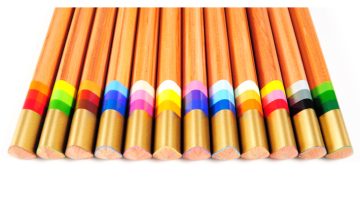 Optical fibres have a wide range of applications, such as transmitting data around the globe, letting doctors peer inside their patients and even brightening up Christmas in the form of tree lights. These kind of fibres have been in use for decades, but the latest optical fibres are far more advanced and producing them is more difficult. Thankfully, manufacturers can use mathematical models to simplify the process.
Optical fibres have a wide range of applications, such as transmitting data around the globe, letting doctors peer inside their patients and even brightening up Christmas in the form of tree lights. These kind of fibres have been in use for decades, but the latest optical fibres are far more advanced and producing them is more difficult. Thankfully, manufacturers can use mathematical models to simplify the process.
The first optical fibres consisted of a transparent “core” surrounded by a transparent “cladding” material with a lower refractive index, trapping light inside thanks to the phenomenon of total internal reflection. The latest generation of fibres, known as “holey fibres”, have a much more complicated structure that allows them to transport fluids or solids in atomic quantities, in addition to light signals. Made from a single layer of glass, these new fibres contain patterns of air holes running throughout their entire length. Development on holey fibres began in the previous decade, and manufacturers are still learning the best methods for producing them.
Optical fibres typically have a diameter of about 0.5 millimetres, not much larger than a human hair. Producing a fibre that is many miles long but still keeps a consistent diameter and internal structure is difficult at this size, so fibre manufacturers work at a larger scale. They start with a glass “preform” that is much wider than the eventual fibre, with a diameter of around 5cm, from which they can produce many miles of fibre. The preform is suspended and heated in a furnace until the glass begins to melt, allowing the manufacturers to draw out a single glass fibre and wrap it around an automated roller. The glass cools as it is drawn from the preform, and the result is a long, thin fibre.
This method works well for basic fibres with no internal structure, but producing holey fibres isn’t as simple since holes created in the preform won’t necessarily be preserved in the final fibre. Molten glass flows like a liquid and can fill in holes, while the surface tension of the glass can cause holes to change shape. Fibre manufacturers need new techniques to counter these effects.
One technique is to rotate the preform or the fibre as it is drawn, averaging out any imperfections. This also produces a centrifugal force that fights against surface tension to keep the holes open. Another technique is to hold the holes open through pressurisation by pumping air into the preform and sealing off the ends. Applying these techniques isn’t an exact science, and it isn’t always clear what kind of fibre will result from a given preform, so manufacturers often need to make multiple attempts to produce the fibre they need. Experimenting with different methods is an expensive process though, as manufacturing a preform may cost thousands of pounds.
To help bring down the costs, fibre manufacturers have turned to mathematicians such as Alistair Fitt and others at the University of Southampton to predict what happens when fibres are drawn from a preform. His team’s work identifies the key variables involved in fibre production, and allows manufacturers to focus their experiments on these variables. For example, both the speed at which glass is drawn from the preform and the speed at which it feeds into the roller affect the resulting fibre, but the analysis reveals that these two values are linked. Manufacturers don’t need to test all of the different draw speeds and feed speeds, because the mathematics shows that the key value is the ratio between the two.
 Cutting down the number of possible experiments helps to improve fibre manufacture, but the ultimate goal of mathematical modelling is more ambitious. Fitt’s team hopes to produce a model that takes a given preform and applies a set of key variables, such as temperature and pressure, to predict the structure of the final fibre. They have achieved this for a fibre with a single hole, known as a capillary, showing that different rotation speeds can be used to control the eventual size of the hole in the final fibre. Extending this work to cover a general fibre is more difficult, but mathematical models in the future could even allow manufacturers to produce differently structured fibres from the same preform by simply changing the key variables, further reducing the costs involved.
Cutting down the number of possible experiments helps to improve fibre manufacture, but the ultimate goal of mathematical modelling is more ambitious. Fitt’s team hopes to produce a model that takes a given preform and applies a set of key variables, such as temperature and pressure, to predict the structure of the final fibre. They have achieved this for a fibre with a single hole, known as a capillary, showing that different rotation speeds can be used to control the eventual size of the hole in the final fibre. Extending this work to cover a general fibre is more difficult, but mathematical models in the future could even allow manufacturers to produce differently structured fibres from the same preform by simply changing the key variables, further reducing the costs involved.
Bringing down costs is important if holey fibres are to become as useful as the solid variety. Traditional optical fibres transport light, making them suitable for transmitting data through communication networks, or to create flexible cameras that can be used in surgery or engineering. Holey fibres are more like miniature pipes that can transport a range of materials, and they could be very useful in producing “lab-on-a-chip” devices.
These small devices are designed to provide cheap and easy to use laboratory-style analysis of fluids, simply by placing a sample drop on the chip. For example, a lab-on-a- chip device could be designed to analyse a blood sample for the presence HIV, which would involve the transport of blood around the chip. A holey fibre could be designed for this purpose, even incorporating holes that are initially separated but then come together to enable the mixing of different fluids.
Holey fibres are still in the early stages of development, but they have the potential to provide a new range of applications that aren’t currently possible with traditional fibres. Mathematical modelling of the kind done by Alistair Fitt and his team is helping to bring down the cost of engineering these new holey fibres, and allowing manufacturers to produce better quality fibres than ever before.
Technical Supplement
Modelling fibre manufacture
 The flow of molten glass, like all fluids, can be modelled by the Navier-Stokes equations, a linked set of four nonlinear partial differential equations that are very difficult to solve. Many problems involving these equations are normally solved numerically using computational fluid dynamics (CFD) analysis, but this technique cannot be applied to holey fibres. Each hole increases the computational complexity of the problem, so even the best CFD codes can currently only handle fibres with three holes. Since some fibres can have thousands of holes, CFD is simply not a feasible solution.
The flow of molten glass, like all fluids, can be modelled by the Navier-Stokes equations, a linked set of four nonlinear partial differential equations that are very difficult to solve. Many problems involving these equations are normally solved numerically using computational fluid dynamics (CFD) analysis, but this technique cannot be applied to holey fibres. Each hole increases the computational complexity of the problem, so even the best CFD codes can currently only handle fibres with three holes. Since some fibres can have thousands of holes, CFD is simply not a feasible solution.
Alistair Fitt’s model of holey fibre manufacture treats the molten glass of a fibre preform as an extensional flow. This allows him to convert the partial differential equations into ordinary differential equations, which are much easier to solve. It works well for capillaries, fibres with a single hole, but adding more holes introduces problems. The model divides the fibre into many slices and solves for the flow in each slice, but the difficulty comes when reassembling the fibre. For multi-holed fibres, the flow in each slice won’t necessarily line up with its neighbours, making the solution unworkable.
References
Fitt, A. D., Furusawa, K., Monro, T. M., Please, C. P. & Richardson, D. J. (2002) The mathematical modelling of capillary drawing for holey fibre manufacture. Journal of Engineering Mathematics, 43(2-4), 201-227. DOI: 10.1023/A: 1020328606157
Voyce, C. J., Fitt, A. D. & Monro, T. M. (2008) Mathematical Modeling as an Accurate Predictive Tool in Capillary and Microstructured Fiber Manufacture: The Effects of Preform Rotation. Journal of Lightwave Technology, 26(7), 791-798. DOI: doi: 10.1109/J LT.2007.914515
Voyce, C. J., Fitt, A. D. & Monro, T. M. (2008) The mathematical modelling of rotating capillary tubes for holey-fibre manufacture. Journal of Engineering Mathematics, 60(1), 69-87. DOI: I0.l007/sl0665- 006-9133-3
The IMA would like to thank Professor Alistair Fitt, University of Southampton for his help in the preparation of this document.



